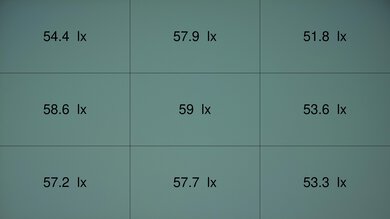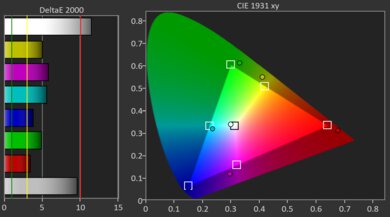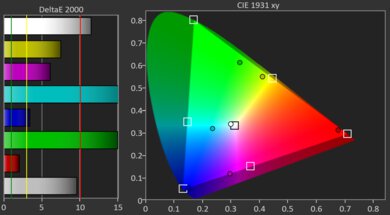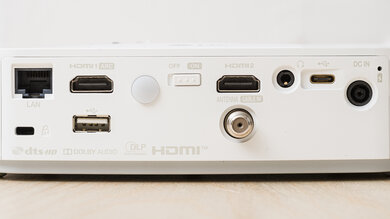The LG CineBeam PF50KA is a portable projector with a 1080p native resolution. It comes with a cut-down version of LG's webOS called Smart TV, alongside Bluetooth and Wi-Fi support. It also comes with Miracast for casting and screen mirroring. It has two HDMI ports, a USB-A 2.0 data port, a USB-C port with power delivery, and a headphone jack, so you can play media from a USB flash drive or SD card or plug in various devices via HDMI. The projector supports ARC, so you can passthrough advanced audio formats if you have a soundbar connected through HDMI. It can project an 80-inch image from a distance of about 75 inches up to a 100-inch image from a distance of 125 inches. The projector comes with built-in 2W stereo speakers.
Our Verdict
The LG PF50KA projector is a poor choice for watching movies in a dark room. It has very bad color accuracy that you can't fully fix with calibration. Its peak brightness is very low, and the projector is too dim to be used in rooms with any lights. Unfortunately, it doesn't fare much better in dark rooms as its contrast is disappointing; all scenes are dim, no matter how bright they are. It has a wide color gamut, although the projector isn't bright enough to make its colors pop. Thankfully, it's a small and light portable projector with an integrated battery, making it easy to take with you on the go.
-
Great portability due to its size, weight, auto vertical keystone, and integrated battery.
-
Wide color gamut.
-
Not useable in a room with lights due to its awful peak brightness.
-
Doesn't impress in dark rooms due to its disappointing contrast.
-
Very inaccurate, and can't be fully fixed through calibration.
- 4.4 Movies
Changelog
- Updated Aug 07, 2024: Review published.
- Updated Aug 01, 2024: Early access published.
- Updated Jul 03, 2024: Our testers have started testing this product.
- Updated Jun 26, 2024: The product has arrived in our lab, and our testers will start evaluating it soon.
- Updated Jun 18, 2024: We've purchased the product and are waiting for it to arrive in our lab.
Check Price
Differences Between Sizes And Variants
We bought and tested the LG PF50KA. LG has a wide selection of CineBeam projectors, from cheap portable models all the way to expensive higher-end home cinema products. This is one of the highest-tier models in LG's portable lineup, which includes models like the LG PH150G, LG PH510P, and LG PF510Q. There are slight differences between them: the cheaper PH150G and PH510P are 720p projectors without an integrated smart operating system. The PF510Q is a 1080p projector with more smart features than the PF50KA due to its inclusion of the full webOS alongside HDCP support, letting it play content from streaming apps seamlessly. However, it doesn't have the PF50KA's USB-C port, making it a bit less versatile when it comes to charging or streaming content from connected media devices.
Our unit was manufactured in October 2022; you can see the label here.
Compared To Other Projectors
The LG PF50KA is a poor projector; we don't recommend buying it. It's very dim, making it hard to use in any room with lights, and its contrast just doesn't impress in darker rooms. It's also very inaccurate out of the box, and you can't fully fix it through calibration. While it's very portable due to its size and integrated battery, the KODAK LUMA 350 has all that, is even smaller, and comes in at a lower price point. If you don't need the integrated battery, the XGIMI MoGo 2 is a cheaper and far superior option.
Check out our recommendations for the best portable projectors and the best outdoor projectors. If you'd prefer to shop for another product in the same price range, look up the best projectors under $500 instead.
The Samsung The Freestyle 2nd Gen is better than the LG CineBeam PF50KA. While the Samsung doesn't have an integrated battery like the LG, it has full auto keystone correction and autofocus, making it easier to move around than the LG; just ensure access to an outlet or external battery pack. Otherwise, the Samsung projector is much more accurate out of the box, can be calibrated, and has a wider color gamut, giving it better image quality. It also has a nifty swivel stand, letting you adjust its projection angle vertically very easily.
The XGIMI Halo+ is far better than the LG CineBeam PF50KA. The XGIMI is even more portable due to its full suite of image correction features while being noticeably brighter. The XGIMI projector also has better contrast than the LG, making it the better choice for any room condition.
The XGIMI MoGo 2 Pro is better than the LG CineBeam PF50KA. The XGIMI is even easier to move around due to its full suite of image correction features. Unfortunately, unlike the LG, it doesn't have an integrated battery, so you need to plug it into an outlet or external battery pack. Otherwise, the XGIMI is brighter and has better contrast, making it easier to use in a variety of rooms.
The Anker Nebula Capsule 3 Laser is better than the LG CineBeam PF50KA. The Anker is even more portable due to its smaller size and full suite of image correction features. It has slightly better brightness and contrast than the LG, so it looks better in all rooms regardless of lighting. The Anker is also much more accurate out of the box and can be made even more accurate through calibration.
The KODAK LUMA 350 and LG CineBeam PF50KA are about equally good, although the KODAK is significantly smaller; it's so small you can put it in your pocket. The LG is otherwise extremely portable, but not to the point of being pocketable. Regarding image quality, the two projectors are quite bad, so ultimately, the KODAK has a slight edge due to its size.
The XGIMI MoGo 2 is better than the LG CineBeam PF50KA. The XGIMI is even easier to move around due to its full suite of image correction features. Unfortunately, unlike the LG, it doesn't have an integrated battery, so you must plug it into an outlet or external battery pack. The XGIMI only projectors images in 720p, so the LG is sharper overall due to its 1080p image. Still, the XGIMI is brighter, has better contrast, and is much more accurate, giving it a better, if softer, image overall.
Test Results
The LG PF50KA has a compact design, weighs only 2 pounds, and has an integrated battery, making it very portable. The manufacturer rates its battery to last up to 2.5 hours. It has auto keystone correction, but only on the vertical axis, so you still need to manually adjust the geometry on the horizontal axis. It lacks autofocus, so you need to adjust it manually whenever you move it. Finally, the projector comes with built-in 2W stereo speakers.
This 1080p DLP projector uses an LED bulb as its light source, and it is rated for up to 30,000 hours by the manufacturer, so you likely won't ever have to worry about replacing it. As it's a 1080p projector, it's limited to a 1080p @ 60Hz resolution. It projects a 60" image at a distance of about 75 inches from the wall/screen up to a 100" image at 125 inches.
The LG PF50KA has poor peak brightness, although its uniformity is exceptionally good. Still, it's not bright enough to be used in a room with ambient light, so you're best to use it in dark rooms.
This projector has disappointing contrast. It looks dim no matter how bright the scene is, although it performs slightly better in brighter scenes.
Unfortunately, the LG PF50KA has very bad accuracy out of the box. Greens are overrepresented in all shades of gray. Inversely, blues and especially reds are underrepresented in all shades of gray, with the exception of blacks and near-blacks. Colors are very inaccurate, with purples leaning blue, cyans leaning green, greens leaning yellow, and yellows leaning green. The unit's color temperature is too cold, giving everything a blue tint. Finally, gamma is slightly off the mark, as all scenes are brighter than they should be.
The projector's accuracy is better after calibration but still poor overall. You can't do anything to fix the reds; no matter how much you push the 2-point or 20-point settings, reds are still underrepresented in most shades of gray. Even pushing the red color sliders to their upper limit doesn't significantly improve the situation, and then you introduce visual artifacts in the process. Still, white balance and color accuracy are slightly improved from their pre-calibration state, and the gamma is now almost exactly on target.
This projector uses a toned-down version of LG's proprietary webOS as its smart OS, which LG calls Smart TV. It has full casting support through Miracast, so you can share your phone or laptop screen directly to the projector. The projector comes with built-in 2W stereo speakers.
Comments
LG CineBeam PF50KA: Main Discussion
Let us know why you want us to review the product here, or encourage others to vote for this product.
Update: Due to changes in pricing, we’ve replaced the Winix 5500-2 with the Levoit Core 300 as our budget pick. We also made minor edits for clarity.
What do you think of these changes? Let us know
























